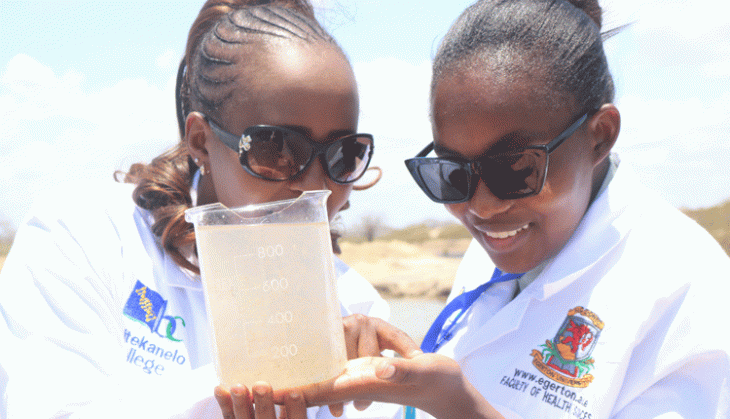Brine shrimp farming offers Kadzuhoni residents new lifeline

Charles Lwanga
For many years, Magarini salt belts in Kilifi county have been regarded as unproductive for crop production following the effects of salt extraction.
But for residents of Kadzuhoni, also located within the salt belt at Gongoni, the negative effects brought by the corrosive substance on their lands has not deterred them from making a fortune out of the salty water tapped from the Indian Ocean and empty basins left after salt extraction activities.
Our visit to the salt belts found about 100 residents, mostly women of Kadzuhoni, busy digging ponds under the supervision of Kenya Marine and Fisheries Research Institute (KMFRI) and researchers from Maseno University to breed brine shrimp (Artemia) for marine aquaculture production.
Artemia are aquatic crustaceans that thrive in salty habitats, such as salty lakes, coastal lagoons and evaporation salt works.
Pastor Johnson Sulubu, chairman of Kadzuhoni self-help group said since the introduction of brine shrimps in the 1980s in the area to enable salt firms produce high quality salt, locals have been tapping brine shrimp for sale at KMFRI.
“We have been selling wet brine shrimp collected from the ponds left after extracting salt and sell them to KMFRI at Sh800 per kilogramme,” he said.
Pastor Sulubu said although there still exists land ownership disputes between community and salt firms, many residents are slowly abandoning crop farming along the salt belt for mariculture.
“Look at this land, the water in the ponds is salty – it has also affected the soil and is unable to sustain crops such as maize, beans, coconut among others.
Locals have turned to artemia production to make ends meet after receiving support from KMFRI,” he said.
New technology
Researchers at Maseno University’s Fisheries and Natural Resources department led by Dr Erick Ogello and KMFRI’s aquaculture research scientist Maureen Mukami say they have discovered a technology known as biofloc, which shall enable them produce large quantity of brine shrimps after research showed artemia are rich in protein for fingerlings.
“With the use of biofloc technology, we are targeting to produce 80 to 100 kilogrammes of Artemia cyst (brine shrimp eggs) within one acre pond.
Currently, farmers are producing around three to 10 kilogrammes of artemia per acre of pond, which is way too low.
This technology is used in other countries such as China, Vietnam and India to produce Artemia in large masses,” says Dr Ogello.
Dr Ogello indicated that artemia is a gold mine, with huge potential to change the livelihoods of the local communities following the discovery of biofloc technology.
“The floc formation is encouraged by local ingredients such as molasses and chicken manure,” he said during a tour to the ‘Artemia production technology for sustainable aquaculture development project funded by Western Indian Ocean Marine Science Association (WIOMSA) at Kadzuhoni
The Maseno University lecturer and researcher was also accompanied by locals, KMFRI researchers, nutrition students from Botswana and Dr Maureen Cheserek from Egerton University.
Dr Ogello said research has established that artemia is a good source of protein for fish and can be used to feed fingerlings in hatcheries to increase the population of fish and facilitate enough fish, especially in the marine population, which has not been doing well.
“Artemia also produces cyst used as fish food, which are in high demand in the international market due to their rich protein where a kilogramme of artemia cyst sells at Sh7,700.
This has an opportunity to change the economic status of the community,” he said.
“Another benefit of artemia is that it eats algae, thus cleans water, and in effect lowers the cost of salt production, and enhances the quality and quantity of salt produced.
Artemia has been used globally as food for larval fish to improve fish larviculture production in hatcheries and ensure high production of quality larval fish seeds.
It can as well be used as a protein source to formulate aqua-feed for grow-out fish,” he shared.
Mukami, who is also the Artemia specialist at KMFRI said artemia was introduced in the country in 1985 at Fundisha salt firm, currently Krystaline salt factory in Magarini, Kilifi county to enhance the production of high-quality salt.
“The brine shrimp species from San Francisco Bay in United States, which is the smallest species of Artemia are loved by fish farmers as they are able to feed fingerings, prawns, crabs among other marine fish. It was introduced after research by KMFRI and Ghent University in Belgium in 2010,” she said.
Locals wash, sieve and dry artemia for sale to KMFRI as food feeds although some countries use them to prepare baby porridge, cakes and soup due to their rich protein nutrient,” she added.
On her part, Dr Cheserek, said they toured the project following collaboration with Maseno University on the artemia production and they are interested to learn how it can be used to improve nutrition.
“Fish is important food for human nutrient. We want to learn how artemia can be used to improve nutrition for children, women and even men since research show the crustacea is used to make baby porridge, soup and even cakes in Indonesia as it is rich in protein,” she said.











